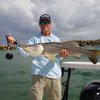Tips on How to Buy a Fishing Rod & Reel
Buying a fishing rod and reel may at first seem a very simple and straight forward process. For the most part, this is the case; however, there are many options and factors available for an individual seeking to purchase a new outfit. One of the biggest considerations may often times involve price. But taking time to determine exactly what is needed and how you will be using the new equipment before heading out to make a purchase can, in the long run, save a potentially large amount of money.
At one time, it was much simpler to choose a fishing pole than it is today. Few choices were available, something that is not true now with the advent of a huge assortment of fishing rods for specific purposes. The best way for you to be able to pinpoint which fishing rod will suit your needs is to do so based on the type of fishing you engage in the most
Here are a few options to consider for inshore, near shore and flats fishing.
Rods:
1. Choose the length of spinning rod. Six to seven foot rods are suited for artificial and live bait casting. They are able to catch fish such as snook, redfish, trout and other inshore flats fish that may visit the bays and back waters. This size rod allows for long casting distances if needed.
2. Test the grip of the rod. Make sure the handle fits snugly in your palm. Is it too heavy or to light for your type of fishing? Remember, you might be casting a lot during the day.
3. Test for flexibility. Hold the spinning rod in your hand as if you are casting, flip the end, and watch the tip for movement. You want some flexibility and sensitivity at the end of the rod.
4. Decide what you are willing to pay for a fishing pole. You get what you pay for in a rod. Expensive poles will last longer and perform better than inexpensive ones.
Reels:
Again, the most important factor to consider is what type of fishing best describes you. There are so many brands of salt water spinning reels on the market today that it would be wise to seek out the top known salt water brands. Some of the brands are: Penn, Shimano, Daiwa and Shakespeare and there are others.
1. The reel should be light/medium weight and be able to hold 200 to 250 yards of 15lb. to 25lb. test lines. I use the braded lines for my reels.
2. Make sure they are salt water reels as they will withstand our harsh environment a lot better than fresh water equipment. Mid-price range would be $90 to $175.
3. Once you decide on the right spinning reel, set it up on the rod in the store. Fill the weight and balance of the combo rod and reel together. The reel should not fill heavy on the rod you chose.
4. Remember to flush off your equipment with fresh water after every trip in salt water. Salt water can leave corrosive elements that can destroy even the most expensive gear.
Most sporting goods and tackle stores have experts to help you choose the rod and reel for your type of fishing. Have an idea of how often you're going to fish, what type of fish you want to catch, where you'll be fishing and how much you want to spend. Their fishing knowledge will make your selection more satisfying.
Capt. Gary Burch
www.allcatchcharters.com

